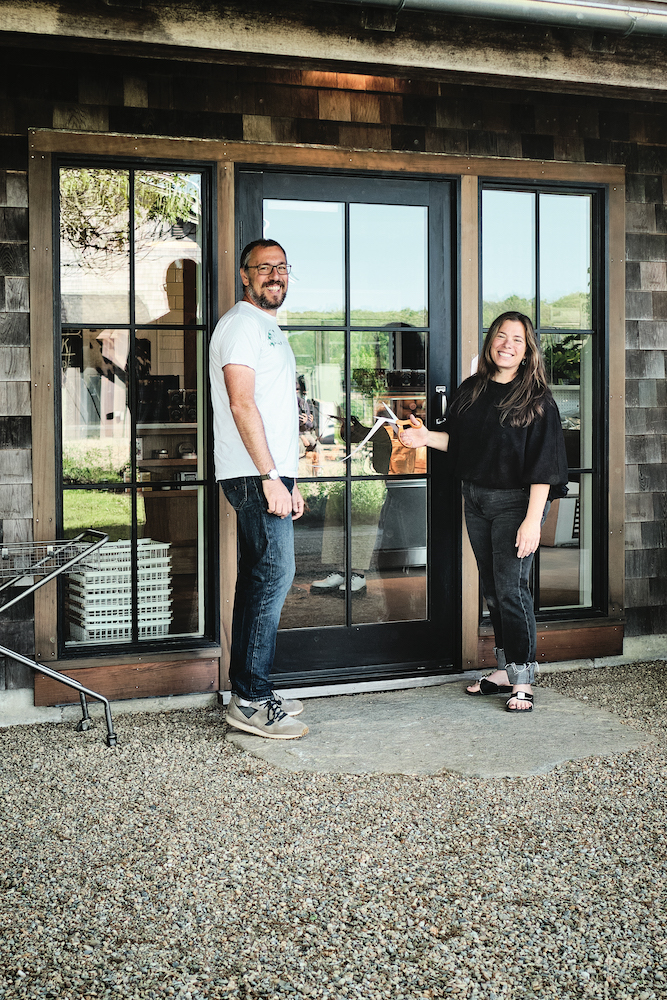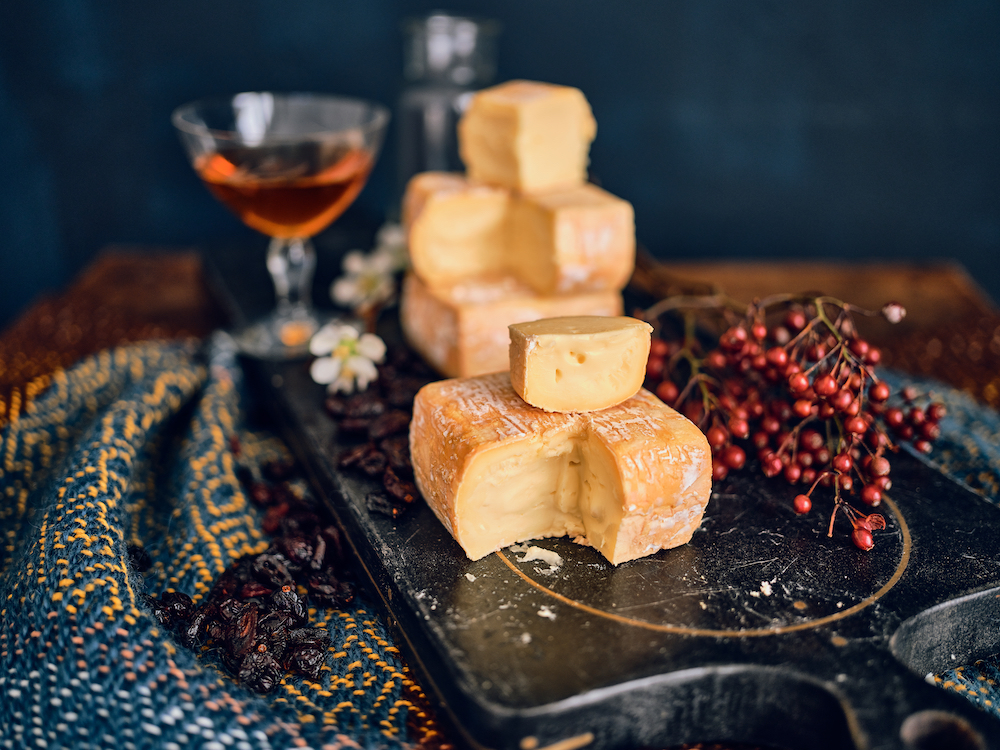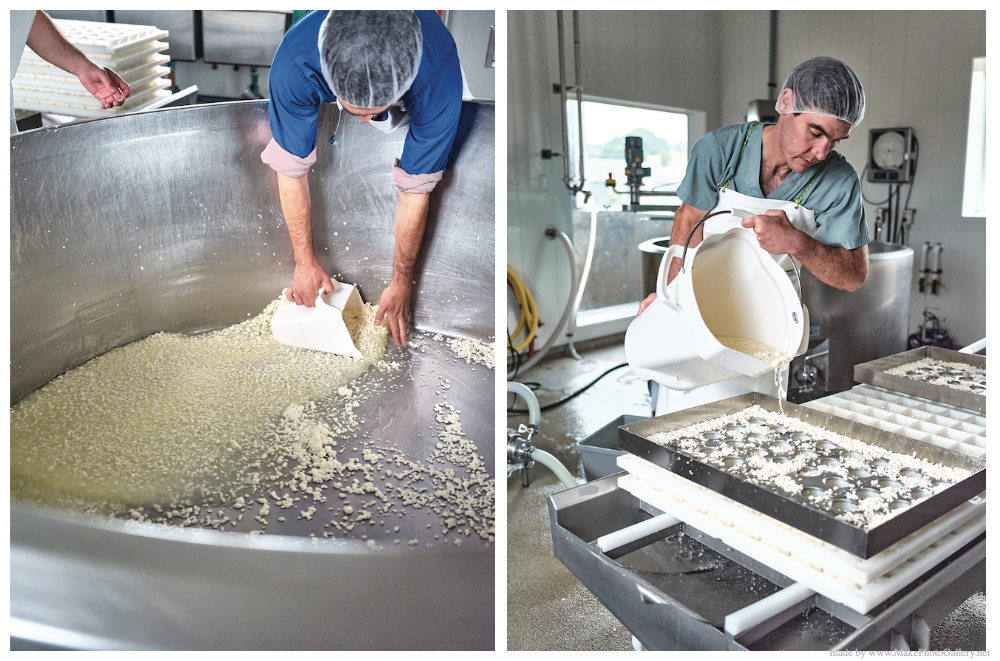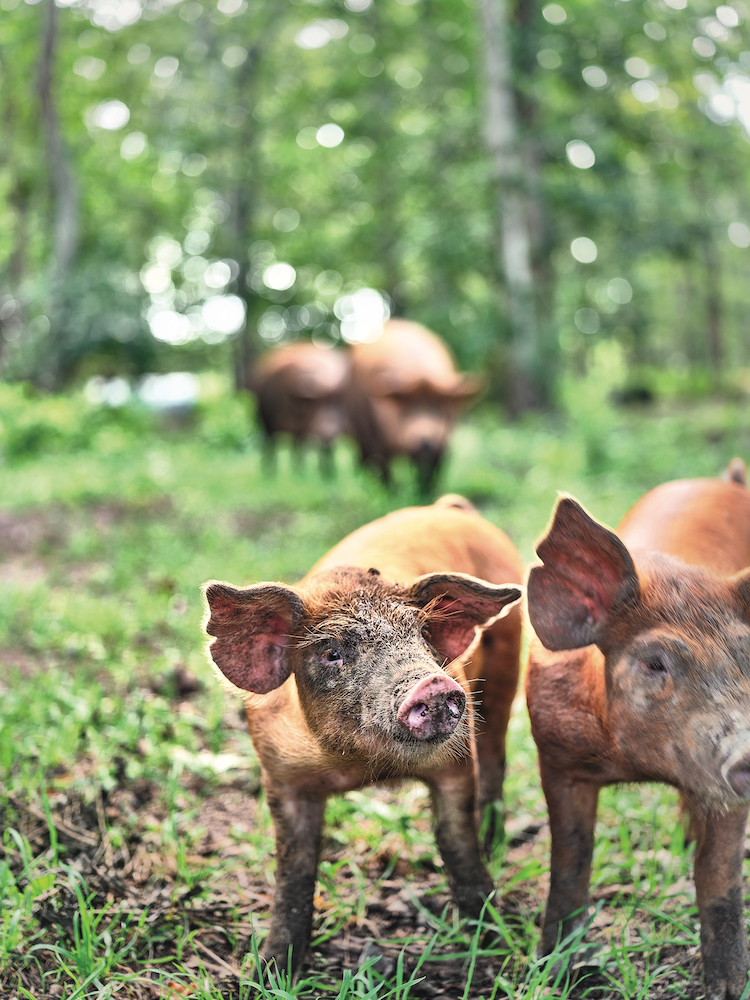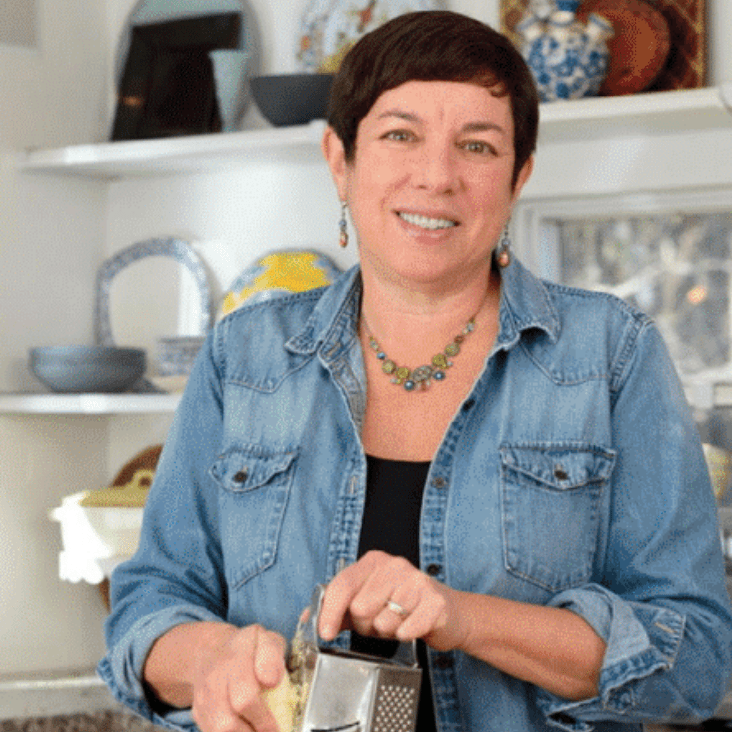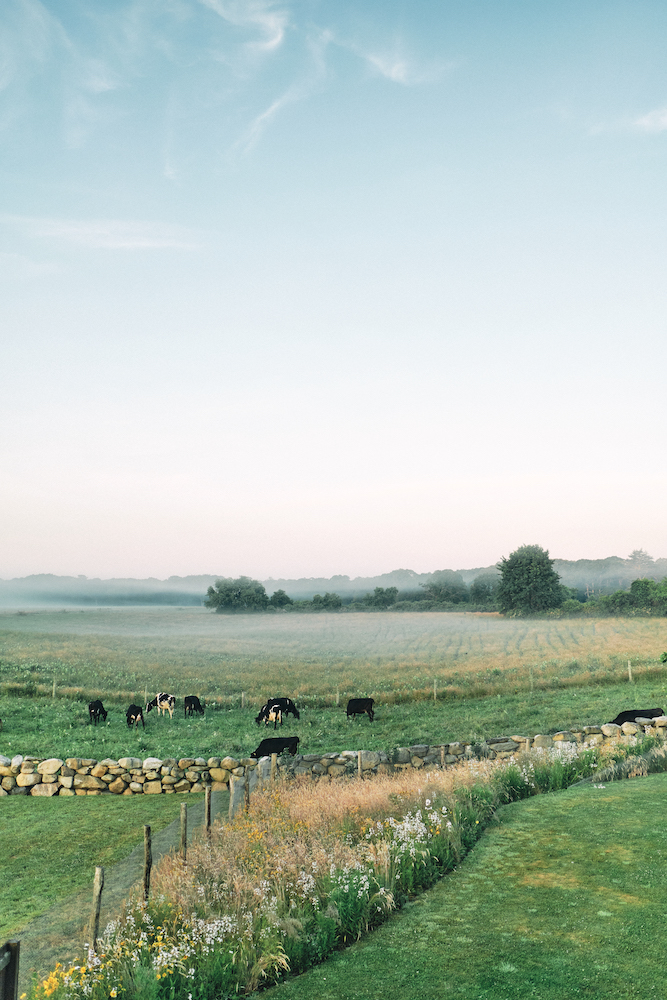
Dairy cows graze at The Grey Barn and Farm
Photographed by Molly Glasgow
When Molly and Eric Glasgow bought the 100-acre farm now known as The Grey Barn and Farm in Chilmark, Massachusetts, on the island of Martha’s Vineyard, they knew almost nothing about farming. The couple had been living in London, where Eric was a commodities trader and Molly was an art director and, after their two sons were born, a stay-at-home mom. In 2009, after spending several summers vacationing on the island, they began to dream about what it might be like to live there full time.
“When we found this property, I felt like I had found my spiritual home,” recalls Molly. It’s mid-September 2021 and we are sitting in the farm’s original barn, talking about the nationally known cheeses The Grey Barn and Farm now produces, and the growth and change that has occurred in just over a dozen years.
In the early 1900s the farm functioned as a community center for all up-island dairy farmers. (“Up-island” is a term that locals use to refer to the three towns on the western end of the island. “Down-island” refers to the other three towns on the eastern end.) “Back then, there were over 1,000 dairy cows up-island,” Molly explains. “Everyone would bring their milk here, and it would then go down-island to Katama to be made into butter and shipped out to Boston. But overtime the dairy industry faded out as the island became more of a tourist destination.”
These days, during the busy summer season, there are more celebrities than cows. After all, this is the island where Barack Obama, Larry David, Carly Simon, James Taylor, Spike Lee, Amy Schumer, and many other luminaries spend summers. Land is at a premium.
When the Glasgows acquired their property, it had not been a working farm since 1961, but they were committed to sustaining the land for agricultural purposes. In 2012 Grey Barn became the second certified organic farm on the island—and the only dairy farm to obtain the designation. “Organic certification brings us closer to the land and aligns with our values of sustainability and responsible practice,” says Molly. “It’s crucial to the farm’s ethos that our practices give back to our land and to our animals, not extract from them. It’s been our goal since day one to give our animals free, clean, and happy lives. Their lives allow us to live our lives.”
Both Molly and Eric have long been interested in food and where their food comes from. “Eric was a chef in Chicago and wanted to go to culinary school, but his parents said, ‘No, a nice Jewish boy goes to business school and becomes a banker!’” Molly says. “And I always loved to bake.”
When they bought the farm, it was decided that Eric would oversee the business end of things and Molly would be the cheesemaker. “No one on the island was making cheese at the time. So, I went to cheesemaking classes at the University of Vermont. We bought some cows and got started.”
But not long afterwards, Molly began to have health issues. “It turned out that I have a dairy allergy and ulcerative colitis,” she says. “Then in 2013 we had a fire and the original creamery burned down. That same year my dad passed away, and it all felt like too much. I was done, but Eric wanted to rebuild. That’s when Joe came into the picture.”
Joe Alstat, that is: The master cheesemaker at Grey Barn. At 7 a.m. on a September morning, Alstat and another cheesemaker, David Aeschliman, have been heating milk for about three hours. They are making a batch of Grey Barn’s award-winning cheese, Prufrock. (All but a few of the cheeses are named after poems. In this case the name is a nod to “The Love Song of J. Alfred Prufrock” by T.S. Eliot.)
The two men work in the early morning quiet, admiring the yellow-white color of the organic milk from the farm’s dairy cows, a herd of about 50 that includes Dutch Belted, Friesian, Swedish Red, Jersey, and Normande breeds. It is the blend of their milk, as well as the grasses they feed on (green pasture in the summer, hay from the farm in the winter), and the island air that creates the flavor of the Grey Barn cheeses.
Over the next few hours cultures will be added to the milk, then rennet. Once the milk has coagulated it will be cut and stirred, and curds and whey separated until it resembles something akin to silken tofu. The mixture is then poured into molds where it goes into the aging cellar for 20 days.
“Prufrock is our most popular cheese,” Alstat says. “It was developed to be easy to love. People are intimidated by stinky cheese. They want it to be more inviting. Prufrock is not going to snap you over the head. There are notes of butter—it’s got a simple, soft, creamy texture.” It’s this combination of buttery, nutty flavor that has brought major attention to Grey Barn: Prufrock won the coveted gold at the 2021 World Cheese Awards, a silver at the 2021 New York International Cheese Competition, and recently picked up a 2022 Good Food Award, among other accolades.
Once the cheese is placed in the aging cellar, Alstat and Aeschliman scour the cheesemaking room until every bit of it is spotless—avital part of the process. Before leaving for the day, Alstat makes the rounds to visit the cows, feeds them a handful of grass, and gives them an affectionate pat on the head. He seems to understand that if the cows aren’t happy—and who wouldn’t be at this gorgeous farm with its stone walls and rolling hills—then he can’t make great cheese.
When asked how much the environment of this 87-square-mile island six miles off Cape Cod adds to the cheese, Alstat says it’s hard to pin down. “I think all Grey Barn cheeses have a clean, almost sweet flavor. Would this cheese taste different if we made it in Vermont? Sure, but I’m not sure how. A lot of terroir isn’t quantifiable.”
Molly sees it differently. “We are an island, surrounded by salty air from the nearby ocean. The cheese doesn’t taste salty, but your mouth has that same sensation that your skin has after a day at the beach,” she says. “Other times it tastes like the pasture. The flavor changes with the seasons.”
What makes one cheese an award winner and another just cheese?
“Joe and David are artists,” says Molly. “They are constantly paying attention and pulling the most flavor from the cheese. It’s that unknowable side of cheesemaking, the part that doesn’t involve science, that makes Grey Barn cheeses so exceptional.”
In addition to cheesemaking, the Glasgows grow five acres of organic vegetables, operate an in-house bakery, which produces some of the island’s best breads and pastries, and raise whey-fed pigs and laying hens. The modern, European-style farm stand and bakery opened in the summer of 2021 to instant acclaim. The Grey Barn and Farm cheeses are also available through Di Bruno Bros. and Saxelby Cheesemongers.
TASTING NOTES
Prufrock
Milk: Pasteurized cow
The Grey Barn and Farm’s first cheese is also its most celebrated, having won numerous national and international awards. This buttery, nutty, washed-rind cheese is full-flavored yet doesn’t overwhelm; with rich notes of brine and yeast, it’s an ideal match for fruit and crusty bread.
Bluebird
Milk: Raw cow
This salty, soft, creamy blue cheese is flecked with tiny crystals, which give it a wonderful texture. Bluebird Reserve, aged for 6 months, won bronze at the 2021 World Cheese Awards. As blue cheese goes, it’s got a punch but is mild enough to draw in those who think they aren’t true blue lovers.
Eidolon
Milk: Pasteurized cow
A bloomy-rind wheel inspired by the French cheeses, Chaource and Coulommiers, it gets its name from the Walt Whitman poem, “Eidolons.” Hand-salted and shaped into flat cylinders, with a white rind that develops naturally, Eidolon is rich, creamy, and full of bright, grassy notes.
Bon Anniversaire
Milk: Raw cow
First made in celebration of Grey Barn’s tenth anniversary, this washed-rind cheese is characterized as funky, bold, and oozy.
RipRap
Milk: Raw cow
A hard, Alpine-style cheese made in the fall from summer milk (rich and full of grassy flavors), this cheese ages in Grey Barn’s caves until a natural rind forms. It’s released each May at the farm.


